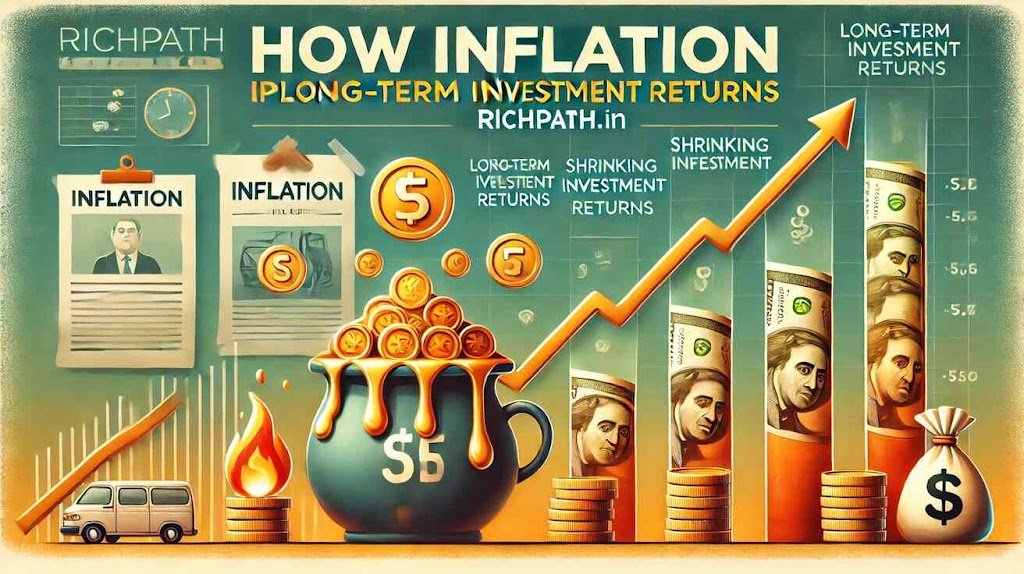How Inflation Impacts Long-Term Investment Returns

Inflation is often called the “silent wealth killer” because its effects erode the value of money over time. For investors, understanding how inflation impacts long-term investment is crucial to ensuring that their portfolio not only grows but also retains its purchasing power.
In India, inflation fluctuates due to factors like economic policies, global trends, and market conditions. This makes inflation impacts long-term investment an important aspect of financial planning. In this guide, we will explore inflation’s effects on investments, strategies to mitigate its impact, and real-life examples to help you inflation-proof your portfolio.
What Is Inflation?
Inflation refers to the rate at which the prices of goods and services rise over time, reducing the purchasing power of money. Simply put, ₹100 today will buy fewer goods and services in the future if inflation continues to rise.
Example:
If the annual inflation rate is 6%, an item that costs ₹1,000 today will cost ₹1,060 next year. Over ten years, assuming inflation remains constant, the same item will cost ₹1,790.
Inflation in the Indian Context
In India, inflation impacts long-term investment due to various factors, including:
- Rising Fuel Prices: Increased transportation costs lead to higher prices for goods.
- Food Inflation: Supply chain disruptions can cause food prices to fluctuate significantly.
- Government Policies: The Reserve Bank of India (RBI) adjusts interest rates to control inflation.
Historical Inflation Trends in India:
Inflation rates in India have varied from double digits in the 1980s to more moderate levels of 4-6% in recent years. However, even moderate inflation can significantly affect long-term investments if not accounted for.
How Inflation Impacts Long-Term Investment
1. Erosion of Purchasing Power
The most direct way inflation impacts long-term investment is by reducing real returns.
Example:
Ravi, a 30-year-old investor in Bengaluru, earns 8% annual returns from a fixed deposit. If inflation is 6%, his real return is only 2% (8% – 6%). Over time, this significantly affects his wealth.
2. Fixed-Income Investments Lose Value
Fixed deposits, bonds, and recurring deposits provide stable returns, but their purchasing power declines with inflation.
Example:
Priya, a 40-year-old teacher in Chennai, invests ₹10 lakhs in a fixed deposit with a 5% annual return. With an inflation rate of 6%, her real returns are negative (-1%), meaning her money is losing value over time.
3. Volatility in Equity Markets
Equities generally outperform inflation, but high inflation increases costs for businesses, affecting profits and stock prices.
Example:
During periods of high inflation in India, FMCG and consumer durables sectors experience reduced demand due to rising costs, leading to stock price fluctuations.
4. Real Estate as an Inflation Hedge
While real estate often provides inflation-adjusted returns, rising inflation increases borrowing costs due to higher interest rates. This can slow down real estate market growth.
5. Commodities as a Double-Edged Sword
Gold and other commodities are safe-haven assets during inflation, but they can be volatile. Investors must balance their exposure to these assets.
Compounding vs. Inflation
While compounding helps in wealth creation, inflation impacts long-term investment by reducing its effectiveness.
Example:
Aman, a 35-year-old software engineer in Mumbai, invests ₹1,00,000 annually in a mutual fund offering 12% returns. Over 20 years, he accumulates ₹72 lakhs. However, with an average inflation rate of 5%, the real value of his corpus is reduced to ₹37 lakhs.
This highlights the need to factor in inflation when planning investments.
Strategies to Minimize Inflation’s Impact
1. Invest in Inflation-Beating Assets
Investing in equities, real estate, and inflation-indexed bonds can help offset inflation’s impact.
Example:
Seema, a 28-year-old marketer in Pune, allocates 70% of her portfolio to equity mutual funds, ensuring her investments grow faster than inflation.
2. Diversify Your Portfolio
A well-diversified portfolio reduces risk and ensures stable returns.
Example:
Meena, a 45-year-old business owner in Ahmedabad, diversifies her investments into 50% equities, 30% debt, 10% gold, and 10% real estate.
3. Invest in Inflation-Indexed Bonds (IIBs)
Government-issued Inflation-Indexed Bonds (IIBs) provide returns linked to inflation, ensuring real value is preserved.
4. Increase Savings to Counter Inflation
Since inflation erodes purchasing power, increasing savings ensures you meet future financial goals.
5. Regular Portfolio Reviews
Reviewing investments periodically helps adjust asset allocation based on changing inflation trends.
Real-Life Case Study: Ramesh’s Retirement Plan
Ramesh, a 50-year-old government employee from Jaipur, planned to retire at 60 with a corpus of ₹1 crore. He invested heavily in fixed deposits, earning 6% annual returns. However, with an inflation rate of 5.5%, his real corpus value reduced to ₹85 lakhs in today’s terms.
Had Ramesh shifted 40% of his portfolio to equity mutual funds and 10% to gold, he could have achieved higher inflation-adjusted returns.
Tools to Track Inflation in India
- Consumer Price Index (CPI): Measures changes in the cost of goods and services.
- RBI Inflation Reports: Regular updates on inflation trends and monetary policies.
- Online Inflation Calculators: Websites like Groww and Zerodha provide inflation impact calculators.
Key Takeaways
- Inflation impacts long-term investment by reducing purchasing power and affecting returns.
- Fixed-income investments are vulnerable to inflation, making it essential to invest in inflation-beating assets like equities and real estate.
- Diversification, regular portfolio reviews, and investments in inflation-indexed bonds can help protect wealth.
- Always factor in inflation when planning financial goals to ensure that your investments retain their real value.
Conclusion
Inflation is an unavoidable reality, but by understanding how inflation impacts long-term investment, investors can take proactive steps to secure their financial future.
For Indian investors, the key is to stay informed, diversified, and disciplined. Whether you are investing for retirement, a child’s education, or wealth creation, accounting for inflation ensures your investments remain strong over time.
Remember, the best way to fight inflation is not to avoid it but to plan for it effectively.
Investment Disclaimer
The information provided in this article is for informational purposes only and does not constitute financial, investment, or legal advice. Mutual fund investments are subject to market risks, and past performance is not indicative of future results. Readers are advised to assess their financial situation and consult a qualified financial advisor before making any investment decisions. Richpath.in is not responsible for any losses incurred based on this information. Please read all scheme-related documents carefully before investing.
For expert financial insights, visit Rich Path. and start your investment journey today! 🚀
Read more –
What is a Flexi Cap Mutual Fund? A Beginner’s Guide to Flexible Investing
Best Flexi Cap Mutual Funds to Invest in 2025
Flexi Cap Mutual Funds vs Multi Cap Mutual Funds
Parag Parikh Flexi Cap Mutual Fund: Last 5, 10, 15 Years Analysis and Future Predictions
Flexi Cap Mutual Funds: 1-Step solution
HDFC Flexi Cap Fund Full Analysis: Unlock Growth Potential with This Dynamic Investment








